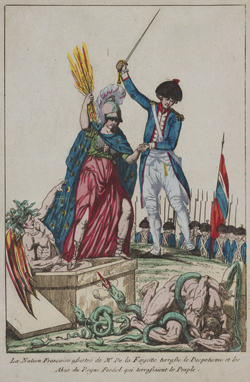Introduction: The Cornell Lafayette Collection

“La Nation Francaise Assistee de M. De laFayette.”
Cornell French Revolution Collection
Cornell University celebrates the 250th anniversary of the birth of Lafayette with an exhibition of the Library’s extensive Lafayette Collection, the largest of its kind in America. Formed in the 1960s through the generosity of Arthur H. and Mary Marden Dean, the Lafayette Collection is unparalleled outside of France as a resource on Marie Joseph Paul Yves Roch Gilbert Du Motier, marquis de Lafayette (1757-1834). Housed in the Library’s Division of Rare and Manuscript Collections, the collection now numbers more than 11,000 original manuscripts, documents and letters, and associated books, images and artifacts.
The formative part of Cornell’s Lafayette Collection was preserved for many decades at Lafayette’s ancestral estate, Château de Chavaniac, in Auvergne, France. Ithaca-born lawyer and diplomat Arthur H. Dean (Cornell class of 1921) acquired the collection from the heirs of French antiquarian dealer and collector Dieudonné Elie Fabius (dead in 1942), who himself had acquired the contents thereof during the period 1912 to 1940 from descendants of Lafayette. Dean donated it to his alma mater in 1964. In 1966, once again through the generosity of Dean and his wife, Cornell expanded its Lafayette holdings with the acquisition of the Lafayette Collection of Marcel Blancheteau, a noted Parisian book dealer.
Cornell Library’s strength in materials documenting the history of France in the eighteenth and early nineteenth centuries originated with Andrew Dickson White, Cornell’s first President. A scholar, educator, diplomat, and lifelong book collector, White pursued his interest in the French Revolution by building a collection of more than seven thousand revolutionary books, pamphlets, newspapers, and manuscripts. Today, Cornell’s French collections draw students and scholars from across the campus and around the world. The Lafayette archive remains a key component of those collections, providing an essential resource for any researcher undertaking serious biographical work on Lafayette and his circle. “Citizen of Two Worlds” offers the most comprehensive display of the Cornell Lafayette Collection since its inaugural exhibition in 1964.